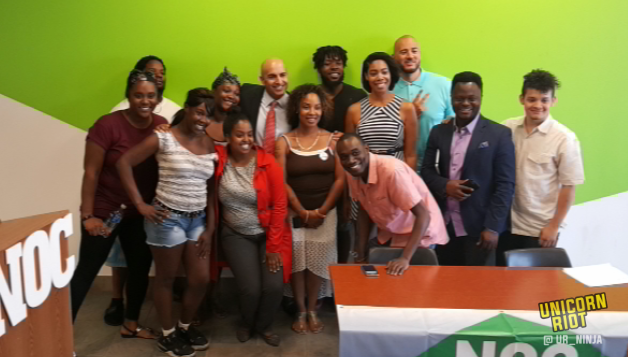Federal Reserve President Commits to Helping Bridge Black Economic Disparities
Minneapolis, MN – Neel Kashkari, the president of the Federal Reserve Bank of Minneapolis, joined MNNOC (Neighborhoods Organizing for Change) for a historic meeting on the gaping economic disparities that the Black communities faces both nationally and regionally.
Unicorn Riot was live for the meeting and the subsequent press conference.
LIVE @minneapolisfed Pres @neelkashkari talking 2x structural unemployment in Black America https://t.co/3hddgOMoqZ pic.twitter.com/Xib6uVh6H5
— UNICORN RIOT (@UR_Ninja) August 3, 2016
The meeting took place August 3rd, 2016 at MNNOC’s office, which is located on West Broadway Avenue in one of the state’s most predominantly Black neighborhoods.
The meeting started with introductions that included Kashkari, MNNOC staff and Executive Director Anthony Newby, along with North Minneapolis residents Tenice Hodges, Devon Jenkins, Rosheeda Credit, and Devona Credit.
Immediately following introductions, Kashkari fielded questions and concerns from Northside residents about how the Federal Reserve banks might use fiscal policy to alleviate the economic disparities of Black people in Minnesota.
One woman, Tenice Hodges, explained that despite having a full time job, she and her son are currently unable to secure housing, and live in their vehicle.
After wrapping up the Q&A segment of the meeting, MNNOC staff brought three hard asks to the Federal Reserve President, which he chose to accept.
They were: to spend “a day in the life” of a family of five that struggles to subsist despite being a two-parent household; a meeting with MNNOC staff and others during next month’s high-profile central banker conference, Jackson Hole Economic Policy Symposium in Wyoming; and a commitment to ongoing conversations and work with MNNOC to begin bridging the economic gap faced by Minneapolis’ Black communities.
The day’s meeting wrapped with a press conference complete with participant statements and questions from members of the press.
When asked by a member of Unicorn Riot whether or not Kashkari believed the economic disparities faced by Black people in Minnesota are a crisis, the Federal Reserve President stated:
“I do think that some of the racial disparities are a crisis […] we need to bring overwhelming force to try to address it“.
Unicorn Riot interviewed MNNOC’s Executive Director, Anthony Newby, as well as Policy Director, Abou Amara, about their perceptions of the meeting with Kashkari.
For the full livestreams of the meeting and press conference, see below.
https://vimeo.com/389074354
https://vimeo.com/389079766
What is the Federal Reserve Bank of Minneapolis?
The Federal Reserve System was established in 1914 to create a nationwide fractional reserve banking system, defined by Investopedia.com as “a banking system in which only a fraction of bank deposits are backed by actual cash on hand and are available for withdrawal.” The United States was divided into 12 Federal Reserve Districts.
Minneapolis’ branch opened in May of that year. Its governance structure:
“Each Federal Reserve Bank became a franchised corporation with stockholders, a board of directors, and operating personnel. There were nine directors per Bank—six were elected by district member banks, with three representing the banking community and three the commercial community; three directors, including the chairman, were appointed by the Federal Reserve Board and represented the public. This same structure holds true today.”
The Minneapolis Federal Reserve Bank covers Minnesota, Montana, North Dakota, South Dakota, twenty-six counties in northwestern Wisconsin, and the Upper Peninsula of Michigan, as the ninth district in the system.
Neel Kashkari took office as president of the “Minneapolis Fed” (@MinneapolisFed) on January 1, 2016. He was an assistant secretary in the Treasury Department with oversight over the TARP bank bailout program in the aftermath of the 2008 financial crisis, and worked in the private sector as an aerospace engineer, at Goldman Sachs and PIMCO, a major California investment management firm.
To help our non-profit media collective please consider a tax-deductible donation by clicking the banner below.



